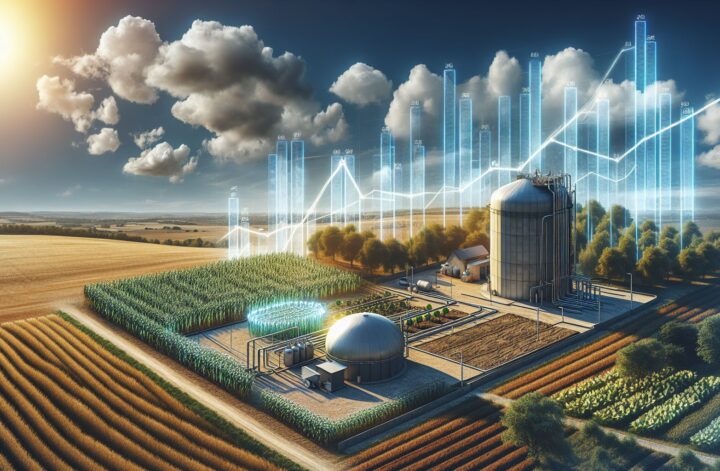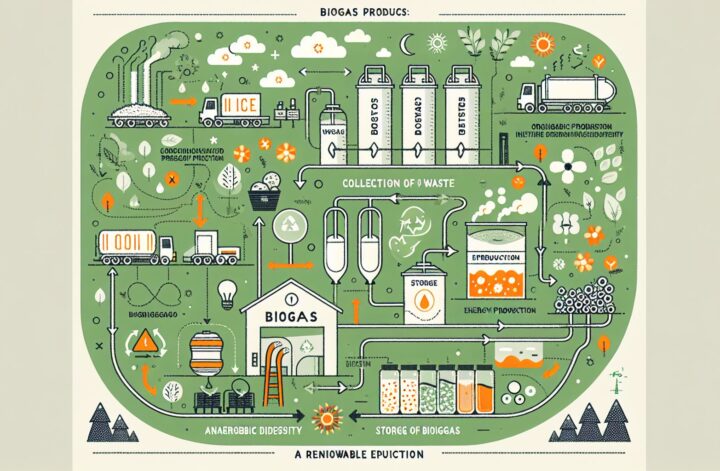Biogas production, quite simply, is the process of converting organic material, or biomass, into a combustible gas mixture, largely consisting of methane and carbon dioxide [^1^]. It has become a particular area of interest for many scientists, researchers, and policymakers due to its potential applications in the realms of waste management and renewable energy production.
The Basics of Biogas Production
The core of biogas production is a biochemical process called anaerobic digestion. This process, carried out by microorganisms, decomposes organic matter in the absence of oxygen, producing a gas rich in methane[^2^]. This methane is the primary “energy carrier” in biogas, and it is for this reason that biogas holds so much potential as a source of renewable energy.
The anaerobic digestion process is divided into four stages: hydrolysis, acidogenesis, acetogenesis, and methanogenesis. These four stages result in the final product: a mixture of gases including methane, carbon dioxide, hydrogen, and others to a lesser extent[^3^].
Hydrolysis
During hydrolysis, complex organic materials such as proteins, carbohydrates, and fats are broken down by hydrolytic bacteria into simpler compounds which are soluble in water.
Acidogenesis
The simpler compounds are further broken down during acidogenesis, turning sugar and amino acids into carbon dioxide, hydrogen, and a range of organic acids.
Acetogenesis
Acetogenesis sees acid-forming bacteria convert the previously formed compounds into acetic acid, hydrogen, and CO2.
Methanogenesis
Lastly, during methanogenesis, methanogenic archaea convert the remaining compounds into the sought-after methane, the primary component of biogas[^3^].
Benefits of Biogas Production
Biogas production has several benefits that contribute to interest in its implementation across the globe.
Renewable Energy Source
The most significant attribute is its status as a renewable energy source. Unlike fossil fuels which take millions of years to form and are finite, the organic waste materials used in biogas production are continually being produced by various sectors, like agriculture, forestry, and households[^2^].
Waste Management Solution
In addition, biogas production offers a solution to the challenging problem of waste management. Rather than considering organic waste as an issue, biogas production recasts it as a resource — one that could help to meet our growing energy demands[^4^].
Decreases Greenhouse Gas Emissions
Moreover, the use of biogas as an energy source can contribute to decreased greenhouse gas emissions. When organic waste decomposes in landfills, methane is released into the atmosphere – a potent greenhouse gas with a global warming potential 28 times higher than CO2 over a 100-year period. But if this waste is harnessed for biogas production, methane is captured and used for energy instead of being released as a harmful pollutant[^4^].
Biogas Production: Challenges and Possible Solutions
While promising, the biogas production process is not without its challenges. Common issues include controlling the process parameters (e.g., temperature, humidity), maintaining the balance of microbial populations, and dealing with waste products. Potential toxicity due to high ammonia or sulfide levels can be mitigated through careful monitoring and control of the feedstock composition[^5^].
Furthermore, the biogas produced often requires upgrading before it can be utilised. Biogas upgrading involves the removal of impurities and enhancement of the gas quality by increasing the methane content, usually through processes such as water scrubbing, pressure swing adsorption, and membrane separation[^6^].
Conclusions
Biogas production offers a promising avenue for both waste management and renewable energy generation. While challenges remain in perfecting the process and implementing it on a broad scale, ongoing research and technological advancements continue to fuel interest in this sustainable energy source and its potential applications.
For a future that’s sustainable and resource-efficient, harnessing the power of biogas is undoubtedly an avenue worth exploring.
[^1^]: Biogas: Developments and Perspectives in Europe. European Biogas Association (2017). http://www.european-biogas.eu/2017/09/27/new-study-biogas-potentials-in-europe/
[^2^]: Anaerobic digestion fundamentals. Environmental Protection Agency, Ireland. https://www.epa.ie/pubs/advice/bioenergy/Anaerobic%20digestion%20fundamentals.pdf
[^3^]: Biogas production process. Energypedia. Retrieved from https://energypedia.info/wiki/Biogas_Production_Process
[^4^]: The value proposition for biogas from organic waste. World Biogas Association (2019). https://www.worldbiogasassociation.org/app/uploads/2019/04/WBA-bas-rep-full.pdf
[^5^]: Technical challenges and operational issues in anaerobic digestion. BioEnergy Consult (2017). https://www.bioenergyconsult.com/challenges-anaerobic-digestion/
[^6^]: Biogas upgrading technologies. Energypedia. Retrieved from https://energypedia.info/wiki/Biogas_Upgrading_Technologies




